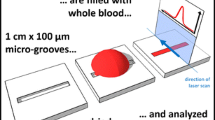Abstract
Screening programs for pediatric lead (Pb) poisoning routinely collect blood by finger stick onto specially designed filter paper (FP) for subsequent laboratory testing. Here, laser ablation inductively coupled plasma time-of-flight mass spectrometry is evaluated as a novel method for the determination of Pb in blood spotted onto FP cards. The method requires no sample pretreatment and may be particularly suitable for rapidly screening a large number of samples. Signal intensity from the ICP-MS strongly correlated (r 2 = 0.996) with Pb target values for five blood cards from a laboratory proficiency testing program. Better precision was obtained by replicate ablation line scans (<15% rsd) compared to a grid of 25 individual ablation spots (>30% rsd). Because <2% of the sample is consumed in the laser ablation analysis, selected samples can also be analyzed by traditional techniques or archived. Lead isotope ratios determined during the same total-Pb analysis appear to be effective for discerning contamination extraneous to the blood sample. Determining that an elevated result was due to contamination may negate the need for retesting with invasive pediatric venipuncture. Some elements monitored along with Pb exhibited signal profiles conducive to potential quantitation (Ca, V, Fe, Cu Zn), whereas others did not (Cr, Mn, Co, Ni, Cd, Hg, Tl, U). Copper, Ca, and V were inversely correlated with Pb (r = −0.89, −0.90, and −0.92, respectively). Scanning electron microscope images revealed surface modality differences between FP spotted with fresh whole blood and reconstituted freeze-dried blood reference material.

Image of spotted filter paper blood specimen showing ablation line scans






Similar content being viewed by others
References
US Department of Heath and Human Services, Agency for Toxic Substances and Disease Registry (ATSDR) (2005) Toxicological profile for lead
Schwartz J (1994) Environ 65:42–55
US Center for Disease Control and Prevention (2000) Morbid Mortal Wkly Rep 50:1133–1137
Pirkle JL, Kaufman RB, Brody DJ, Hickman T, Gunter EW, Paschal DC (1998) Environ Heath Perspect 106:745–750
Pirkle JL, Brody DJ, Gunter EW (1994) JAMA 272:284–291
Stanton NV, Maney JM, Jones R (1999) Clin Chem 45:2229–2235
Collins JA, Puskas SE (2003) MEDTOX Laboratories, Inc. Saint Paul, MN
Wong YW, Ashwood E, Gordon W, Ash O (1995) Clin Chem 41:45
Verebey K, Eng Y, Davidow B, Ramson A (1991) J Anal Toxicol 15:237–240
Yee H, Holtrop T (1997) J Anal Toxicol 21:142–148
Becker JS (2002) J Anal At Spectrom 17:1172–1185
Willie S, Mester Z, Sturgeon RE (2005) J Anal At Spectrom 20:1358–1364
O’Broin SD (1993) Clin Chem 39:1354–1355
Sturgeon RE, Lam JW, Saint (2000) J Anal At Spectrom 15:607–616
Hinners TA, Heithmar EM, Spittler TM, Henshaw JM (1987) Anal Chem 59:2658–2662
Cheng Y, Willett WC, Schwartz J, Sparrow D, Weiss S, Hu H (1998) Am J Epidemiol 147:1162–1174
Barany E, Bergdahl IA, Bratteby LE, Lundh T, Samuelson G, Schutz A, Skerfving S, Oskarsson A (2002) Toxicol Lett 134:177–184
Baltrop D, Khoo HE (1975) Postgrad Med J 51:795–799
Acknowledgements
The author thanks Noel Stanton (Wisconsin State Laboratory of Hygeine) for providing the FP blood specimens. Constructive comments on a draft of this paper were provided by N. Stanton, Bill Balsanek (GBC Scientific), and two anonymous reviewers. SEM images were taken by Robert Fairhurst at the Electron Microanalysis and Imaging Laboratory (UNLV).
Author information
Authors and Affiliations
Corresponding author
Rights and permissions
About this article
Cite this article
Cizdziel, J.V. Determination of lead in blood by laser ablation ICP-TOF-MS analysis of blood spotted and dried on filter paper: a feasibility study. Anal Bioanal Chem 388, 603–611 (2007). https://doi.org/10.1007/s00216-007-1242-y
Received:
Revised:
Accepted:
Published:
Issue Date:
DOI: https://doi.org/10.1007/s00216-007-1242-y




